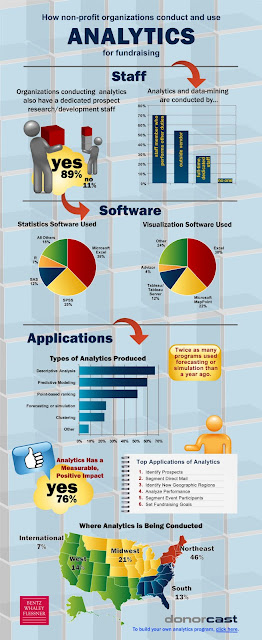5 reasons every nonprofit should use analytics for fundraising
1. Identify Prospects
Anyone working in major gift development realizes, despite all the benefits, wealth screening has its limitations. Most wealth data is not public information, matching is never perfect, and being wealthy alone does not make one a prospect. Predictive analytics can find the individuals fitting your organization’s donor profile. It can help you find the people with the connections, potential passion for mission, and likely wealth. By adding dimensions to your prospect identification, you can find more and better potential major donors.
2. Do more with existing staff
Among the most immediate benefits of predictive analytics is staff efficiencies. Prospect researchers can look at fewer names to find prospects for assignments. This can bring up to double the output from research at many nonprofits. You can contact fewer individuals and net at-or-above previous direct marketing efforts. Analytics is also helpful in tuning processes such as prospect management and engagement strategies.
3. Make better decisions
When I meet with the fundraising staff at most of my clients, they tell me that their executives are not data people. When I meet with the executives, they often say, “No one gives me data around here.” Modern, effective fundraising leadership desires and requires more thoughtful decision support than ever before. Analytics can point out gaps, reveal opportunities, and clarify production clogs better than any tools we’ve had to date. Arming the experienced fundraiser with timely and relevant data can be transformative for nonprofits.
4. Manage data more effectively
Organizations with an eye towards analytics gather and store data in their donor management system differently than other organizations. Initially, they make sure every touch point between constituent and organization is captured. Then, they make strides in capturing process data in a more granular fashion. Rather than simply record contact reports as free text data, analytics enterprises will record where the meetings took place, what steps were taken, adjustments to strategies, and targeting refinements as codes. This enables them to learn how to best cultivate new prospects, engage cold relationships, and bring about sustainable involvement.
5. Raise more money
Productivity is the bottom line of any nonprofit fundraising program. To raise more money, an organization needs to ask more and ask smarter. From setting campaign ask amounts to determining solicitation readiness, and from staffing analysis to measuring return on investment, analytics can help your nonprofit raise more money. And, that’s why we’re here. Isn’t it?
Anyone working in major gift development realizes, despite all the benefits, wealth screening has its limitations. Most wealth data is not public information, matching is never perfect, and being wealthy alone does not make one a prospect. Predictive analytics can find the individuals fitting your organization’s donor profile. It can help you find the people with the connections, potential passion for mission, and likely wealth. By adding dimensions to your prospect identification, you can find more and better potential major donors.
2. Do more with existing staff
Among the most immediate benefits of predictive analytics is staff efficiencies. Prospect researchers can look at fewer names to find prospects for assignments. This can bring up to double the output from research at many nonprofits. You can contact fewer individuals and net at-or-above previous direct marketing efforts. Analytics is also helpful in tuning processes such as prospect management and engagement strategies.
3. Make better decisions
When I meet with the fundraising staff at most of my clients, they tell me that their executives are not data people. When I meet with the executives, they often say, “No one gives me data around here.” Modern, effective fundraising leadership desires and requires more thoughtful decision support than ever before. Analytics can point out gaps, reveal opportunities, and clarify production clogs better than any tools we’ve had to date. Arming the experienced fundraiser with timely and relevant data can be transformative for nonprofits.
4. Manage data more effectively
Organizations with an eye towards analytics gather and store data in their donor management system differently than other organizations. Initially, they make sure every touch point between constituent and organization is captured. Then, they make strides in capturing process data in a more granular fashion. Rather than simply record contact reports as free text data, analytics enterprises will record where the meetings took place, what steps were taken, adjustments to strategies, and targeting refinements as codes. This enables them to learn how to best cultivate new prospects, engage cold relationships, and bring about sustainable involvement.
5. Raise more money
Productivity is the bottom line of any nonprofit fundraising program. To raise more money, an organization needs to ask more and ask smarter. From setting campaign ask amounts to determining solicitation readiness, and from staffing analysis to measuring return on investment, analytics can help your nonprofit raise more money. And, that’s why we’re here. Isn’t it?

